Baby Led Weaning Meal Plan: The Science-Backed Approach That’s Rewiring Your Baby’s Brain
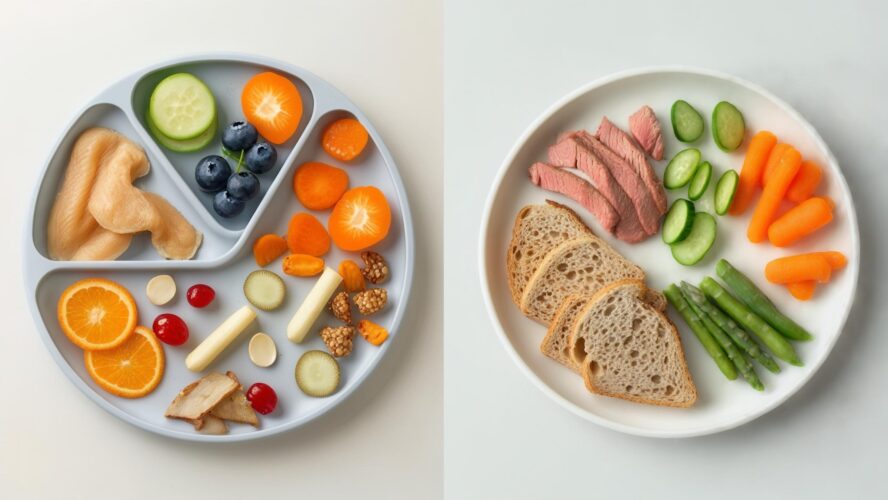
I’ll be honest – when I first heard about baby-led weaning, I thought it was just another parenting trend. But then I started digging into the research and talking to other parents, and wow, there’s actually some pretty compelling stuff here. According to research from the American Academy of Pediatrics, babies who practice baby-led weaning show significantly better self-regulation of hunger and fullness cues, with studies indicating that “toddlers who were weaned using BLW had a lower BMI and incidence of obesity than those who were traditionally spoon-fed” (Huckleberry Care). Here’s something that blew my mind: this early training in listening to their body becomes the foundation for lifelong healthy eating patterns and emotional regulation.
Table of Contents
- The Hidden Neurological Revolution Happening at Your High Chair
- Your Baby’s Gut is Building Its Lifelong Bacterial Army
- How Mealtime Becomes Your Child’s First Social Laboratory
- Setting Up Your BLW Success System (Without Losing Your Mind)
- The Advanced Strategies Most Parents Never Discover
- When Things Go Wrong: Troubleshooting Like a Pro
TL;DR
- Baby led weaning creates unique neural pathways through self-feeding that traditional spoon-feeding can’t replicate, directly impacting future academic skills
- What happens in your baby’s gut between 6-24 months basically sets them up for life – we’re talking mood, immunity, and how well they learn
- Strategic food placement and texture progression optimize brain development through sensory-motor integration
- BLW naturally teaches emotional regulation and stress management through controlled mealtime challenges
- Timing meals with circadian rhythms and seasonal foods maximizes developmental benefits
- Success isn’t measured by food consumption but by self-regulation behaviors and eating independence
The Hidden Neurological Revolution Happening at Your High Chair
Can we talk about something that completely changed how I looked at those chaotic high chair moments? I used to think baby led weaning was just about avoiding the airplane spoon game and, honestly, letting my baby make a giant mess while I stressed about choking prevention. Turns out, I was missing the most incredible part of the whole process.
While I was focused on food prep and safety when starting BLW, the real transformation was occurring in my baby’s developing brain. Here’s the thing though – between 6-18 months, self-feeding creates complex sensory-motor pathways that traditional spoon-feeding simply cannot replicate.
This neurological rewiring impacts everything from spatial awareness to future academic skills. We’re talking about writing and mathematics here. When I learned this, it completely changed how I approached every meal, turning our high chair into what I now call a sophisticated brain development laboratory. (Okay, that sounds fancy, but you get what I mean!)
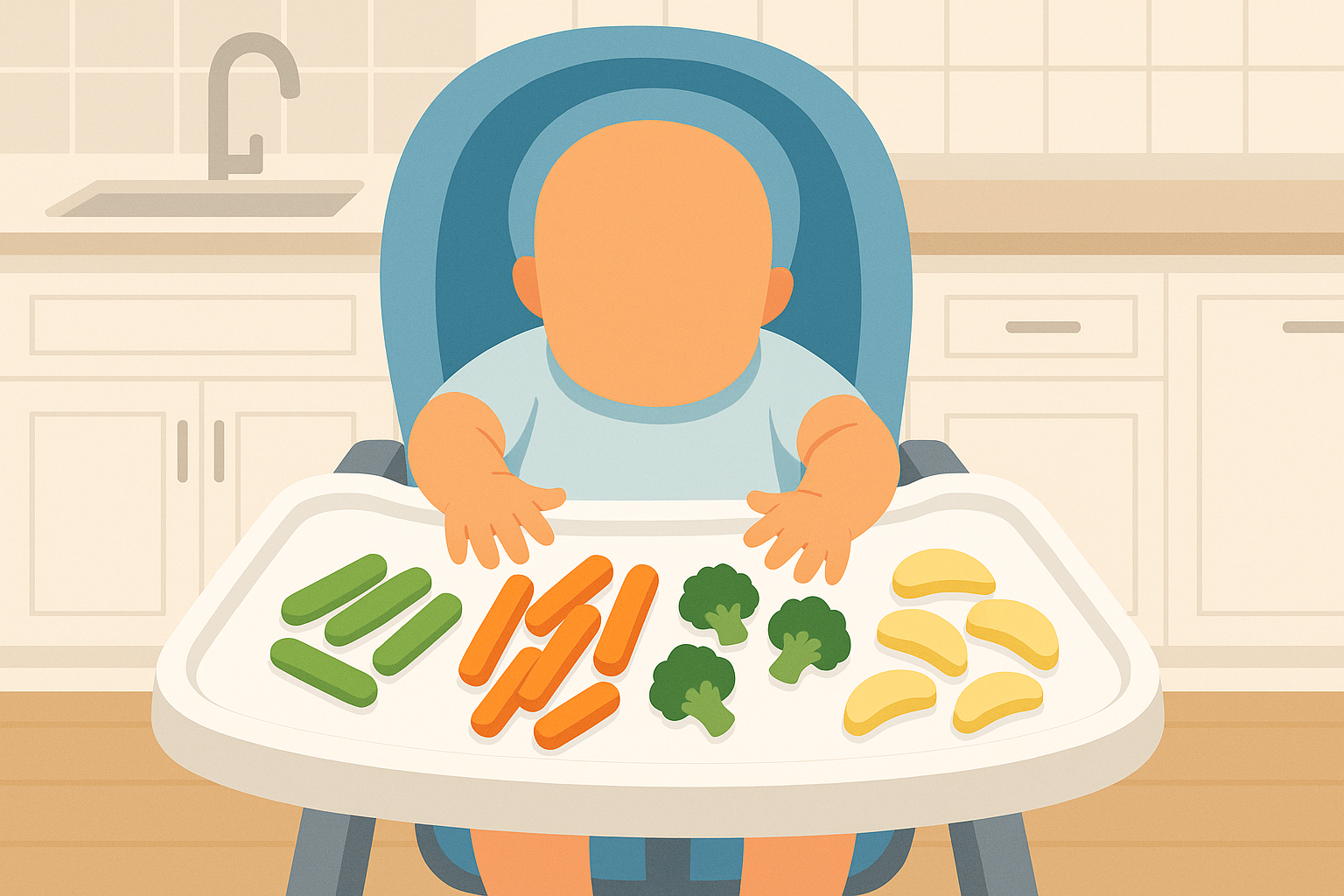
The Critical Window When Your Baby’s Brain Rewires Itself
You know how some skills just seem to come naturally to certain kids? Well, there’s actually a biological reason for that. Your baby experiences a crucial development phase between 6-18 months where hand-to-mouth coordination creates neural pathways essential for spatial awareness and fine motor control. Similar to how certain foods support optimal brain development, the BLW approach creates neural pathways that protect against future learning difficulties.
This isn’t about learning to eat. We’re building the foundation for complex cognitive skills. I’ll never forget watching my daughter wrestle with this piece of roasted sweet potato for what felt like forever. I kept wanting to help her, but my mom brain was like “just let her figure it out.” The way your baby grasps, manipulates, and brings food to their mouth literally shapes their brain architecture in ways that influence learning capacity for years to come. Turns out, all that concentration and finger work? She was basically doing pre-writing practice without knowing it. Mind blown.
Tracking the Pincer Grasp Evolution (And Why It Matters More Than You Think)
Here’s something I wish I’d known earlier: your baby’s pincer grasp development follows a predictable progression that you can actually optimize through specific food textures. I started tracking this progression when I noticed my son’s grip changing week by week, and it was fascinating to watch.
Starting with large soft strips at 6 months, progressing to small soft pieces at 8 months, then introducing varied textures requiring different grip pressures after 10 months creates a systematic approach to neural development through BLW practice. Each texture change challenges different muscle groups and neural pathways. We’re building the fine motor control foundation needed for future writing and mathematical skills.
When I offered my baby those tiny blueberries at 9 months, I wasn’t just giving him a snack – I was helping him develop the precise finger control he’d need for buttoning shirts and typing on keyboards. The progression happens faster than you’d expect. One week your baby is using their whole fist to grab a banana strip, and the next week they’re delicately picking up individual peas with their thumb and forefinger. This BLW journey creates neural pathways that traditional spoon-feeding completely bypasses.
| What You’ll See | What to Offer | Why This Matters (The Cool Part) |
|---|---|---|
| 6-7 months: Whole fist grabbing | Soft finger-sized strips (banana, avocado) | Building basic hand-eye coordination |
| 8-9 months: Fingers working together | Small soft pieces (steamed vegetables) | Those little fingers are learning to work independently |
| 10-12 months: Pincer grasp magic | Mixed textures, small pieces | This is the same skill they’ll need for writing! |
| 12+ months: Refined precision | Complex textures, self-feeding utensils | Advanced cognitive-motor integration |
The Secret to Activating Both Sides of Your Baby’s Brain
Okay, this sounds super fancy, but it’s actually simple. Instead of just dumping all the food in one spot (guilty!), try putting some pieces on the left side of the tray and some on the right. When your baby reaches across their body to grab food, they’re literally connecting both sides of their brain. I felt like such a genius when I figured this out.
I discovered this accidentally when I placed food on just one side of the tray and watched my daughter reach across her body with the opposite hand. That simple movement was activating bilateral brain coordination that supports future reading and math skills through BLW methodology.
Simple BLW placement strategies can dramatically enhance your baby’s brain integration during every meal. Place three pieces of soft steamed broccoli on the left side of the tray, two pieces of banana in the center, and three pieces of sweet potato on the right. This forces your baby to reach across their body with both hands, activating bilateral brain coordination that supports future reading and math skills through BLW methodology.
The beauty of this approach is that it happens naturally. Your baby doesn’t know they’re doing brain training – they’re just reaching for food. But every cross-lateral reach is strengthening the neural highways between their brain hemispheres. I started being more intentional about food placement after learning this, and I could see the difference in how my baby approached problem-solving during BLW meals.
How Different Textures Actually Rewire Your Baby’s Stress Response
Here’s something that completely changed my perspective on those moments when my baby seemed to struggle with new textures. The vagus nerve, which controls digestion and stress regulation, develops optimal tone through varied texture experiences that traditional purees cannot provide. This directly impacts your child’s future stress resilience and gut health.
I never connected texture variety to stress management until I started researching the vagus nerve. When my baby encountered a slightly chewy piece of roasted chicken, I watched him work through the challenge calmly. He wasn’t getting frustrated – he was learning to regulate his stress response through BLW experiences. By systematically introducing textures that stimulate different vagal nerve branches through BLW, you’re essentially training your baby’s nervous system for optimal stress management throughout life.
The Texture Roadmap That Builds Resilience
Creating a systematic approach to texture introduction stimulates vagal nerve branches in a sequence that mirrors optimal nervous system development. Moving from smooth to complex textures in specific weekly progressions builds both eating skills and stress resilience simultaneously.
Starting with smooth soft foods, progressing to foods with slight resistance, then mixed textures, and finally complex BLW foods requiring jaw rotation creates a developmental pathway that supports nervous system maturation. Each texture challenge teaches your baby that they can handle difficulty and work through problems.
I remember the first time I offered my daughter a piece of well-cooked pasta. She had to figure out how to bite through it, chew it properly, and manage the texture in her mouth. The concentration on her face was intense, but she worked through it. That’s vagal nerve training in action through BLW.
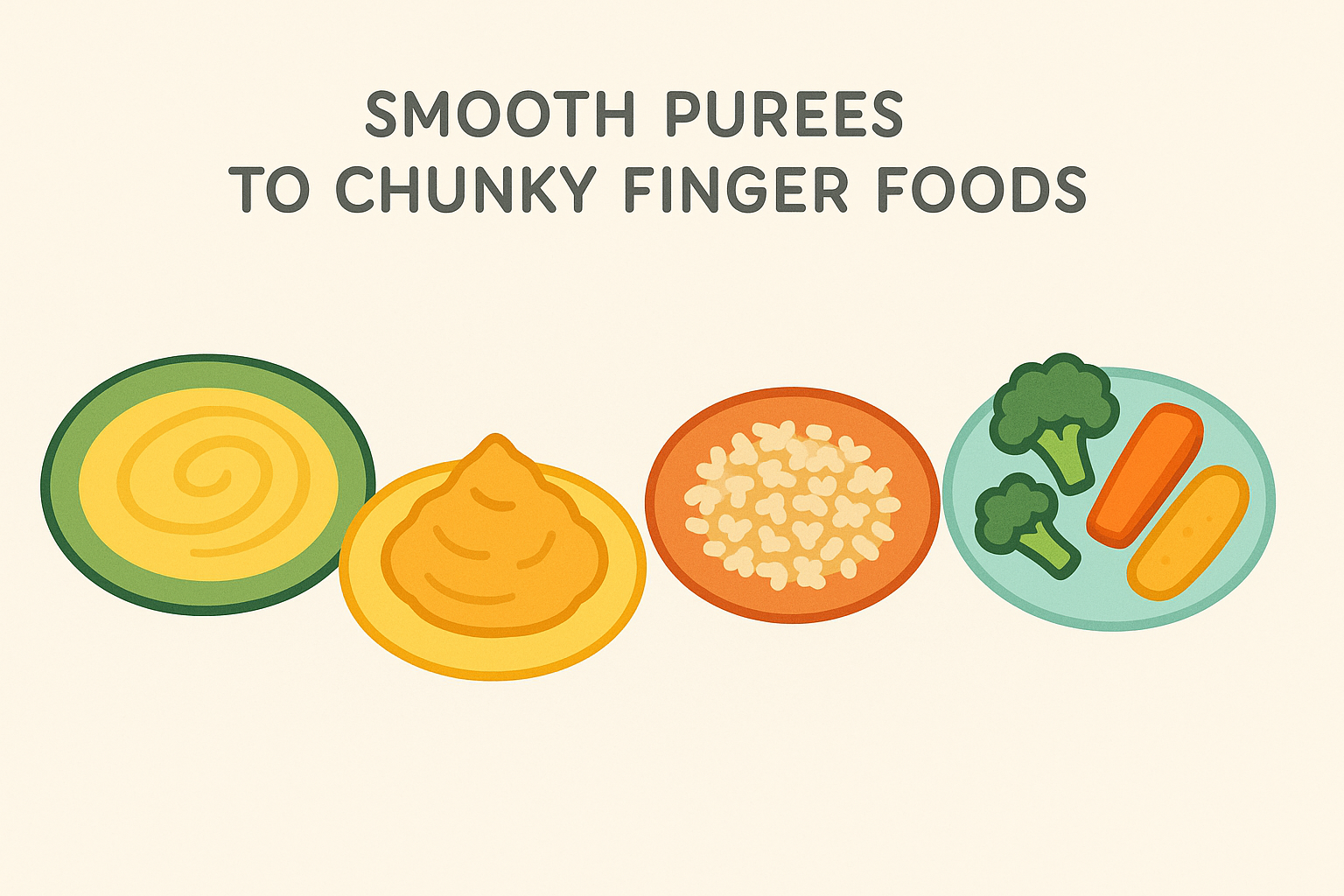
Why Different Parts of Your Baby’s Mouth Matter for Development
You know those moments when your baby stops mid-bite to move food around their mouth with their tongue? They’re not just being picky – they’re actually doing some serious developmental work. Different areas of the mouth provide distinct sensory feedback that influences eating skills, speech development, emotional regulation, and social bonding patterns. Foods that engage front teeth, molars, and tongue movement each contribute unique developmental benefits through BLW.
When I offered my son a strip of cucumber, I watched him explore it with different parts of his mouth. First, he used his gums to break down the softer inside, then he worked the skin with his emerging teeth. Each area of his mouth was sending different sensory information to his developing brain.
Understanding these connections helps you choose foods that support multiple developmental goals simultaneously rather than focusing solely on nutrition. A piece of well-cooked broccoli engages the front teeth for biting, the molars for grinding, and the tongue for manipulation – all while providing essential nutrients through BLW.
Teaching Your Baby to Listen to Their Body’s Signals
I used to stress SO much about whether my baby was eating enough. Anyone else ever feel like they’re failing at lunch before it even starts? Then I learned about something called interoceptive awareness – basically, your baby’s ability to sense internal bodily signals. Baby led weaning uniquely develops this skill, and it becomes the foundation for lifelong healthy eating patterns and emotional self-regulation.
Unlike spoon-feeding, BLW allows babies to experience the natural progression from hunger to satisfaction, training their hypothalamus to recognize and respond appropriately to internal cues. I used to worry when my baby would push food away after just a few bites. Then I learned that this was exactly what should happen. He was learning to recognize when he’d had enough, developing the internal awareness that would protect him from overeating throughout his life through BLW practice.
This natural training system creates intuitive eaters who trust their body’s signals. When babies control their own food intake, they develop a sophisticated understanding of hunger, satisfaction, and fullness that traditional feeding methods can’t replicate.
The Natural Hunger Training System You’re Probably Disrupting
Here’s where I totally got this wrong at first. Allowing babies to determine their own stopping points during meals trains their hypothalamus for optimal hunger-satiety signal recognition. This natural training system gets disrupted when parents encourage “one more bite” or ignore early satiety cues.
I had to resist the urge to encourage more eating when my daughter seemed to eat very little during her first weeks of BLW. But I learned that respecting these signals was crucial for developing her internal regulation system. Understanding and respecting these BLW signals creates the foundation for intuitive eating patterns that prevent future eating disorders and obesity.
The hypothalamus is incredibly sophisticated, but it needs practice to function optimally. Every time your baby decides they’ve had enough and you respect that decision, you’re strengthening their internal regulation system. Every time you override their signals, you’re teaching them to ignore their body’s wisdom.
Your Baby’s Gut is Building Its Lifelong Bacterial Army
Can I share something that changed everything for me? I didn’t realize I was essentially planting a bacterial garden in my baby’s gut during those early BLW months. The timing, texture, and variety of foods in baby led weaning create a fundamentally different gut microbiome landscape compared to traditional weaning. What happens in your baby’s gut between 6-24 months basically sets them up for life – we’re talking about their mood, how often they get sick, even how well they learn.
The way you approach BLW literally shapes your child’s internal ecosystem, making food choices during this period disproportionately important for lifelong health. The diversity of textures and foods in BLW exposes babies to a much wider range of beneficial bacteria than smooth purees ever could.
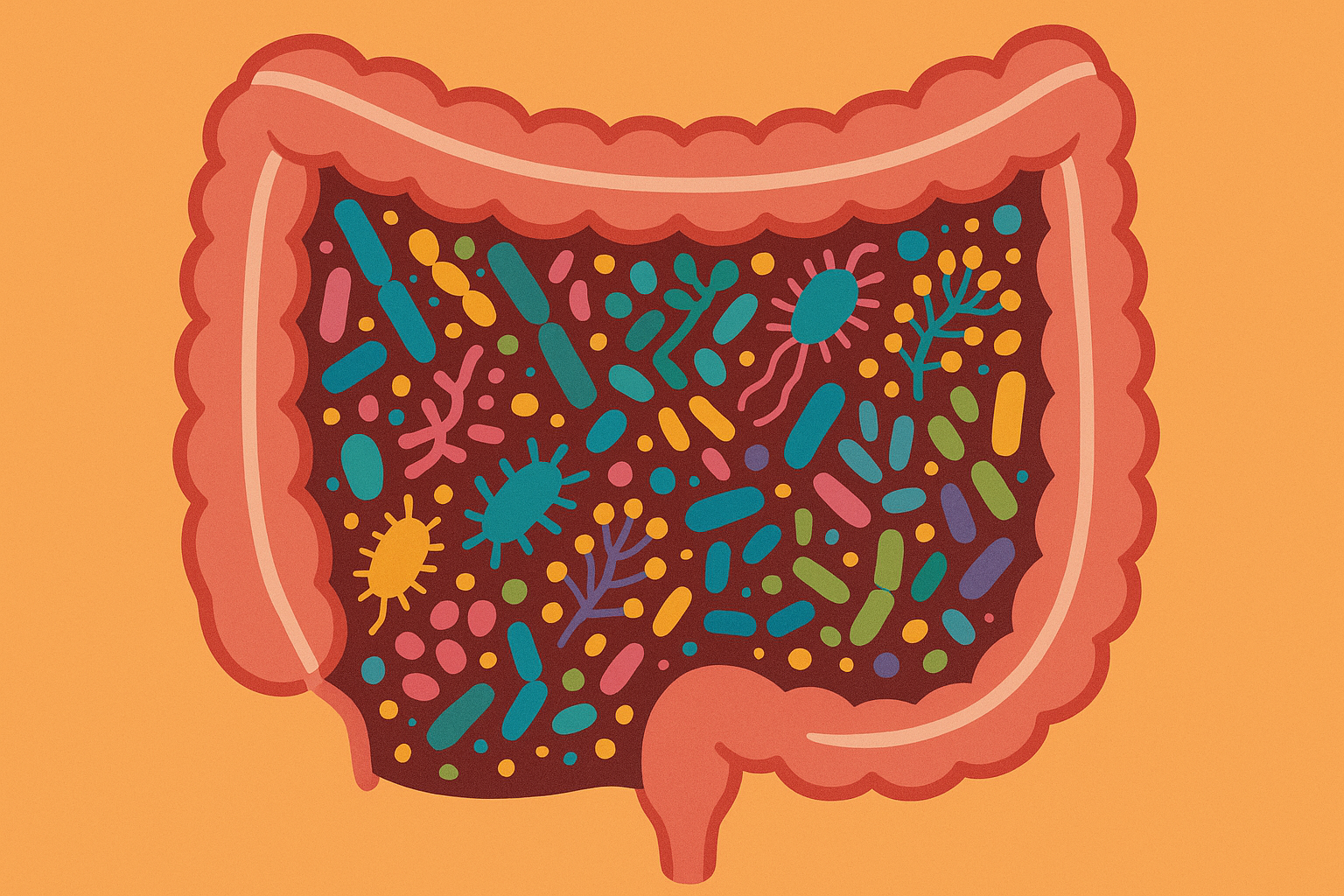
The Once-in-a-Lifetime Bacterial Colonization Window
The 6-24 month period represents a unique opportunity to establish beneficial bacterial strains that may never successfully colonize later in life. During this critical window, your baby’s gut is ready to be planted with the bacterial garden that will influence their health for decades.
Just as fermented foods support adult gut health, introducing diverse BLW textures during this critical window establishes beneficial bacterial strains. Missing this BLW opportunity means certain beneficial bacteria may never establish themselves, regardless of future dietary interventions.
I wish I had understood this earlier. When my first child was going through BLW, I focused mainly on safety and nutrition. With my second child, I realized I was actually programming his microbiome for life. The variety of foods and textures he encountered during those crucial months would influence his immune system, mood, and even cognitive function for decades to come.
The Strategic Fiber Introduction That Feeds Good Bacteria
Here’s something that blew my mind: different fiber types feed different bacterial strains. This means we need a strategic approach that goes beyond simple “fruits and vegetables” recommendations. Starting with simple fibers and progressing to complex fibers creates a systematic approach to bacterial diversity.
Sweet potato and banana provide gentle fibers that feed beneficial bacteria without overwhelming an immature digestive system. As your baby’s gut develops, introducing complex fibers from broccoli and asparagus, then adding resistant starches and fermented BLW foods builds a robust microbiome ecosystem.
Each fiber type supports different beneficial bacteria. When I offered my daughter a variety of fibrous foods during her BLW journey, I was essentially feeding different bacterial populations in her gut. The diversity of her diet directly translated to diversity in her microbiome.
The Food Combinations That Fight Inflammation Before It Starts
Certain food combinations create synergistic anti-inflammatory effects more powerful than individual foods alone, programming the immune system for optimal inflammatory response patterns through BLW. Pairing colorful vegetables with healthy fats, combining sulfur-rich foods with vitamin C sources, and including herbs and spices with each meal creates an anti-inflammatory foundation.
Research shows that “families who follow a baby-led style will expose their infant to a wider range of foods including more textures and flavors than traditional weaning” (Huckleberry Care), with consuming a larger variety of foods being directly associated with better diet quality and health outcomes throughout childhood and beyond.
I started combining foods more strategically after learning about these synergistic effects. Offering avocado with colorful bell peppers, or serving berries with a small amount of coconut oil, created anti-inflammatory combinations that were programming my baby’s immune system through BLW for optimal function throughout life.
Programming Your Baby’s Metabolism for Life
The way babies interact with different macronutrients during BLW creates lasting metabolic programming that influences insulin sensitivity, fat storage patterns, and energy regulation throughout life. This metabolic programming occurs during a critical window when the pancreas and liver are learning optimal glucose management strategies.
The patterns established during this BLW period become the metabolic blueprint your child carries into adulthood. I never thought about my baby’s pancreas learning how to respond to different foods, but that’s exactly what was happening during every BLW meal.
Teaching Your Baby’s Pancreas Optimal Blood Sugar Control
Allowing babies to self-regulate carbohydrate intake through BLW teaches their pancreas and liver optimal glucose management strategies that prevent future metabolic dysfunction. Understanding how different foods affect digestion helps parents make informed choices about which foods to offer during BLW meals.
Offering complex carbohydrates paired with protein and fat, avoiding isolated simple sugars, and including naturally sweet whole foods rather than processed options creates the foundation for stable blood sugar regulation throughout life. When I offered my son sweet potato with a small amount of almond butter, I was teaching his pancreas how to handle carbohydrates in the healthiest way possible through BLW.
The self-regulation aspect of BLW is crucial here. When babies control their own intake, they naturally balance their macronutrients in ways that support optimal metabolic programming. They might eat more fat one day and more carbohydrates the next, following their body’s natural wisdom.
How Mealtime Becomes Your Child’s First Social Laboratory
You know those moments when your baby stops mid-bite to stare at your face while you’re eating? They’re not just being cute (though they totally are). They’re studying you like little scientists, figuring out how this whole eating thing works by watching the pros – aka you.
Baby led weaning transforms mealtime from a caregiver-controlled feeding session into a complex social learning laboratory. During these shared eating experiences, babies develop emotional regulation, learn to read social cues, and form family bonding patterns that shape their relationship with food and others.
I started noticing how much my baby was learning about social interaction during BLW meals. She would watch my facial expressions when she tried new foods, mirror my chewing motions, and even attempt to share her food with me. This social-emotional development component of BLW is often overlooked but may be the most important aspect for long-term wellbeing.
The dinner table becomes a place where babies learn about communication, sharing, patience, and family dynamics. These lessons extend far beyond nutrition, establishing patterns of connection and communication that influence relationships throughout life.
The Emotional Co-Regulation Magic of Family Meals
When babies feed themselves while observing family members eat, they engage in sophisticated emotional co-regulation processes that build secure attachment patterns and emotional resilience through BLW. This shared eating experience creates opportunities for emotional learning that extend far beyond nutrition.
I watched my daughter calm down during stressful meals by observing my relaxed eating behavior. She was learning to regulate her emotions by watching and mirroring my responses. This co-regulation process happens naturally when families eat together during BLW, creating secure attachment patterns that influence emotional development for years to come.
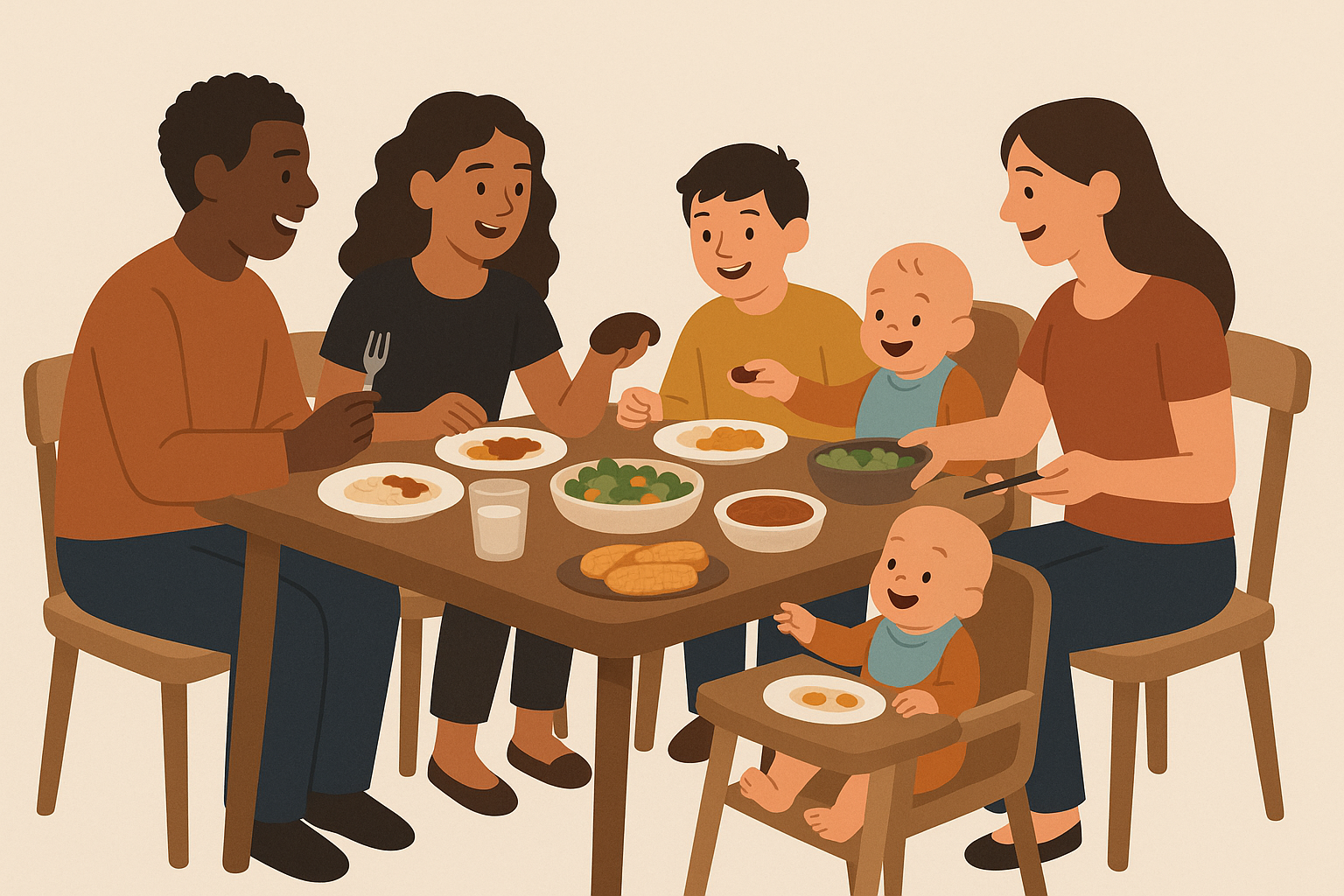
How Your Baby’s Mirror Neurons Learn by Watching You Eat
Babies’ mirror neurons fire when they observe others eating, but only when they’re simultaneously engaging in the same behavior. This creates powerful learning experiences that traditional feeding methods miss entirely. When you eat the same foods as your baby, model calm eating behaviors, and make eye contact during BLW meals, you’re activating sophisticated neural learning systems that shape your baby’s relationship with food and social connection.
Recent guidance from “Texas Children’s Hospital emphasizes that BLW brings the baby to the table with the rest of the family, allowing babies to see how chewing and swallowing are done while learning by watching us eat” (Texas Children’s Hospital), highlighting how this social exposure increases family bonding and creates valuable learning opportunities for developing eating skills.
My son would stop eating and stare at me whenever I took a bite of food. I realized he was studying my jaw movements, facial expressions, and eating rhythm. His mirror neurons were firing, creating neural pathways that would influence his eating behaviors for life through BLW observation.
The Stress Training Your Baby Needs (But You’re Probably Preventing)
Here’s where I had to completely change my approach: BLW naturally creates low-level challenges that allow babies to practice stress regulation in a safe, supported environment. Food falling, difficulty grasping, or managing new textures become opportunities for building resilience and problem-solving skills.
Many parents interfere by immediately helping when babies struggle. I had to train myself to sit on my hands when my daughter dropped food or couldn’t quite manage a piece of chicken. Learning to resist the urge to intervene allows babies to develop crucial stress management skills they’ll need throughout life.
These controlled challenges build confidence. When babies work through eating difficulties independently, they develop a sense of capability that extends beyond mealtime. The frustration tolerance they build during BLW transfers to other areas of development.
Building Cultural Food Identity From the Very Beginning
Baby led weaning allows babies to experience authentic cultural flavors and eating patterns from the beginning, establishing deep cultural food connections that influence identity formation and family bonding. Between 6-18 months, babies can develop positive flavor memories for complex cultural foods that will influence their food preferences and cultural identity throughout life when following a thoughtful baby led weaning meal plan.
Similar to how cultural foods can enhance mood and connection, introducing traditional family flavors through BLW helps establish deep cultural identity from the earliest stages. I started offering my baby the same spices and flavor combinations that were important to our family heritage, watching her develop familiarity with tastes that connected her to generations of family tradition.
The Flavor Memory System That Shapes Identity
Introducing family cultural foods in age-appropriate forms, including traditional spices and seasonings, and connecting food experiences to family traditions creates lasting flavor memories that become part of your child’s cultural identity through BLW. These early flavor experiences create neural pathways that make cultural foods feel familiar and comforting throughout life.
A family with Italian heritage might offer soft strips of roasted eggplant seasoned with basil and olive oil, or tender pasta shapes with tomato sauce, allowing their baby to develop familiar taste preferences for traditional family foods while building cultural food identity from the earliest stages.
The neural pathways formed during this critical period create lifelong preferences. When I introduced my baby to the cumin and coriander flavors that were central to our family’s cooking, I was programming his taste preferences to find comfort in these traditional flavors throughout his life through BLW experiences.
Setting Up Your BLW Success System (Without Losing Your Mind)
Let’s be real – some days this feels like organized chaos. Moving beyond basic safety guidelines, successful BLW requires understanding the subtle environmental, timing, and preparation factors that optimize developmental benefits while minimizing common challenges. Most parents focus on what foods to offer but overlook how the physical environment, meal timing, and preparation methods dramatically impact the neurological and social benefits.
I learned this the hard way after several chaotic meals where everything seemed to go wrong. The difference between a stressful feeding experience and a developmental goldmine often comes down to these practical implementation details when following your baby led weaning meal plan.
These environmental factors aren’t just about comfort – they directly impact how well your baby can integrate the complex sensory information that makes BLW so developmentally powerful.
Creating the Perfect Brain-Building Environment
The physical environment where BLW occurs significantly impacts the neurological and social benefits, requiring specific attention to lighting, seating, and spatial arrangements that most parents overlook. Your baby’s developing brain processes food experiences more effectively in environments with specific characteristics that enhance focus and reduce overstimulation.
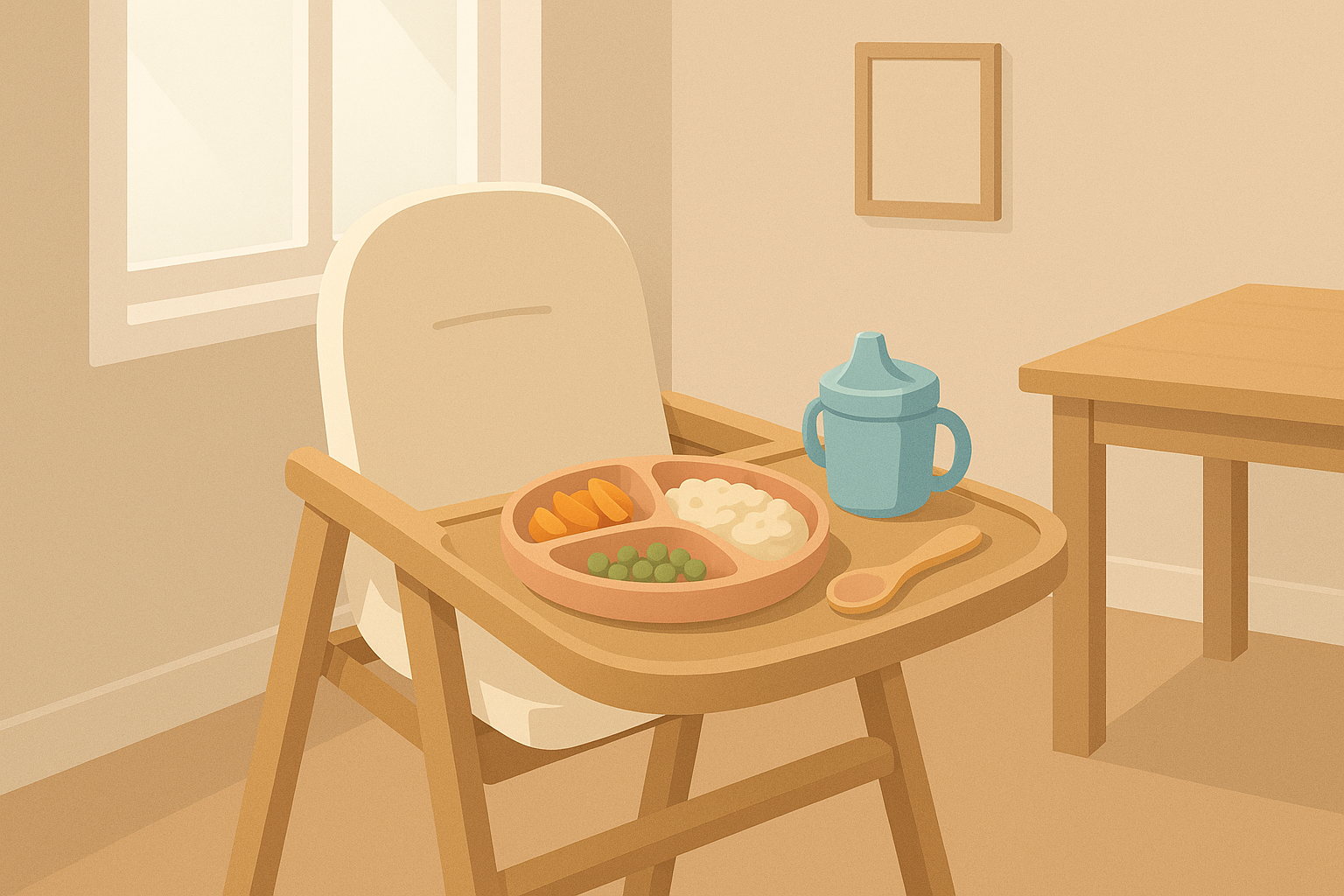
The Sensory Setup That Actually Helps Your Baby Focus
Babies process food experiences more effectively in environments with natural lighting, minimal background noise, and strategic positioning that allows them to see family members’ faces. I noticed my daughter was much more engaged with her food when we ate near a window with natural light compared to under harsh kitchen fluorescents.
These environmental factors directly impact how well your baby can integrate the complex sensory information that makes BLW so developmentally powerful. Basically, if you have to raise your voice to talk over the background noise, it’s probably too loud for optimal baby brain processing. I learned this the hard way when I realized why my son was so much more focused during quiet morning meals versus our chaotic dinner rush.
BLW Environment Checklist:
- Natural lighting or warm, soft artificial light
- Background noise you can easily talk over
- Baby can see at least one family member’s face
- High chair positioned away from distractions (TV, toys)
- Room temperature between 68-72°F
- Easy-to-clean surfaces prepared
- Emergency supplies within arm’s reach
The Independence Training System That Grows With Your Baby
Gradually reducing environmental supports allows babies to develop increasing independence while maintaining safety and confidence. Starting with smaller portions, gradually increasing variety and complexity, slowly reducing physical supports, and allowing increasing meal duration as attention span develops creates a scaffolding system.
This system builds confidence and capability over time through BLW. I started by offering just two food options and gradually increased to four or five as my son’s decision-making skills developed. The key is matching the challenge level to your baby’s current capabilities while providing just enough support to ensure success.
The Timing Science Most Parents Get Wrong
Here’s something I wish I’d known from the start: the specific timing of food introduction, meal spacing, and daily rhythm alignment can dramatically impact BLW success and developmental benefits. Your baby’s digestive system, energy levels, and learning capacity all follow natural rhythms that you can work with rather than against.
I used to offer meals whenever it was convenient for me, but I learned that timing makes a huge difference in how receptive babies are to new foods and textures during BLW.
Syncing Meals With Your Baby’s Natural Body Clock
Aligning BLW meal times with natural circadian rhythms optimizes digestion, nutrient absorption, and sleep patterns. Offering largest meals during natural high-energy periods, keeping evening meals lighter and earlier, and paying attention to your baby’s individual circadian preferences creates a feeding schedule that supports their natural biology.
Most babies have peak energy and curiosity in the late morning and early afternoon. I started scheduling our most adventurous BLW meals during these windows and saw immediate improvements in my baby’s engagement and willingness to try new foods.
The Meal Planning System That Actually Works for Real Families
Unlike adult meal planning, BLW requires considering developmental stages, texture progressions, and nutrient density in ways that support optimal brain development during critical windows. Just as preparing homemade remedies requires advance planning, successful BLW requires strategic meal preparation that considers developmental stages and nutritional needs.
According to feeding specialists, “in phase one of baby-led weaning (first eight weeks), babies should eat solid foods one to two times per day, progressing to two to three times per day in phase two (second eight weeks), and finally three times per day in phase three” (Baby-Led Weaning with Katie Ferraro), creating a systematic progression that aligns with developmental readiness.
Planning weekly menus around developmental milestones, batch prepping foods in multiple textures, creating backup options, and documenting successful combinations creates a sustainable system that reduces daily stress while maximizing developmental benefits through BLW.
| What Phase You’re In | Age Range | Meals Per Day | What to Focus On | How to Prep Like a Pro |
|---|---|---|---|---|
| Phase 1: Exploration | 6-7 months | 1-2 meals | Single textures, getting messy | Batch prep soft strips weekly |
| Phase 2: Skill Building | 8-9 months | 2-3 meals | Self-feeding, combinations | Prep multiple textures, freeze portions |
| Phase 3: Independence | 10-12 months | 3 meals | Family foods, confidence | Adapt family meals, minimal special prep |
| Toddler Life | 12+ months | 3 meals + snacks | Complex textures, social eating | Full family integration |
The Advanced Strategies Most Parents Never Discover
Okay, before we dive into this next part, let me say this: if you’re barely keeping up with basic meals, skip this section for now. Come back to it when you’re feeling more confident. There’s no prize for making BLW harder than it needs to be.
Moving beyond basic first foods, advanced BLW incorporates strategic food categories that serve specific developmental and nutritional purposes. These sophisticated approaches consider how different nutrients interact, how seasonal eating patterns support natural development, and how specific food combinations can measurably impact cognitive development and long-term health outcomes.
I discovered these strategies after months of basic BLW, and they completely transformed our approach to meal planning. We weren’t just feeding our baby anymore – we were strategically supporting optimal development through targeted nutrition combinations.
The Brain-Boosting Food Combinations That Actually Work
Specific combinations of omega-3 fatty acids, choline, and antioxidants during the BLW period can measurably impact cognitive development and neural connectivity formation. Understanding these nutritional synergies allows you to create meals that actively enhance brain development.
These aren’t just healthy foods – they’re strategic brain-building tools for BLW. When I learned about these combinations, I started viewing our high chair as a cognitive enhancement laboratory rather than just a feeding station.
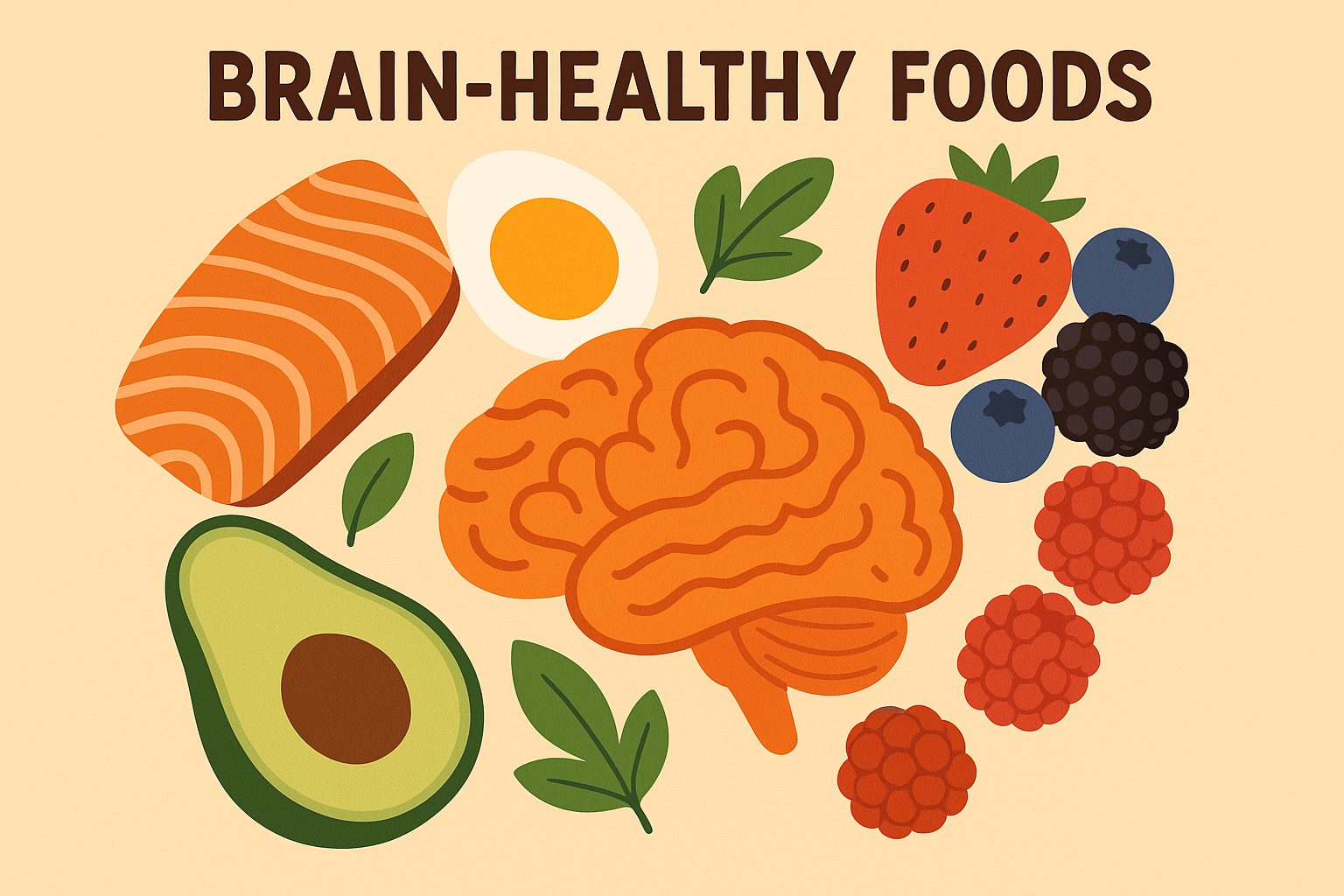
The Cognitive Enhancement Protocol Hidden in Plain Sight
Including wild-caught salmon or chia seeds weekly, offering egg yolks combined with colorful vegetables, rotating different colored berries for varied antioxidant profiles, and including avocado with most meals creates a systematic approach to cognitive enhancement that most parents never consider.
Recent analysis by nutrition experts reveals concerning gaps in commercial baby foods, with “many convenient, squeezable products being low in essential nutrients such as iron and vitamin C, both of which are vital for babies’ brain development, immune function and overall growth” (The Independent), highlighting why strategic nutrient combinations in BLW become even more critical for optimal development.
I started offering my daughter a small piece of wild salmon with roasted sweet potato and avocado once a week. This combination provided omega-3s for brain development, beta-carotene for neural protection, and healthy fats for nutrient absorption – all working together to support optimal cognitive development through BLW.
The Mineral Absorption Game You’re Probably Losing
Many minerals compete for absorption, requiring strategic food pairing and timing to maximize bioavailability during rapid growth phases. Separating iron-rich foods from calcium-rich foods, pairing iron sources with vitamin C foods, including zinc-rich foods away from fiber-heavy meals, and offering magnesium-rich foods with healthy fats creates an absorption optimization system.
This ensures your baby actually gets the nutrients you’re offering through BLW. I learned this after wondering why my son seemed low in iron despite eating plenty of iron-rich foods. The problem wasn’t the foods – it was the timing and combinations.
Serve iron-rich ground beef with bell pepper strips (vitamin C enhances iron absorption) at lunch, then offer calcium-rich cheese and whole grain crackers as an afternoon snack, spacing them 2-3 hours apart to prevent mineral competition and maximize absorption of both nutrients.
The Seasonal Eating Pattern That Programs Long-Term Health
Aligning BLW foods with seasonal availability provides optimal nutrition while training your baby’s system for natural seasonal eating patterns that support long-term health. Focusing on warming foods in colder months, emphasizing cooling foods in warmer months, introducing seasonal fruits at peak ripeness, and connecting seasonal eating to family traditions creates a natural rhythm.
This seasonal approach supports both nutrition and cultural connection through BLW. I started planning our meals around what was naturally available in our region, and I noticed my baby seemed more interested in foods that were in season.
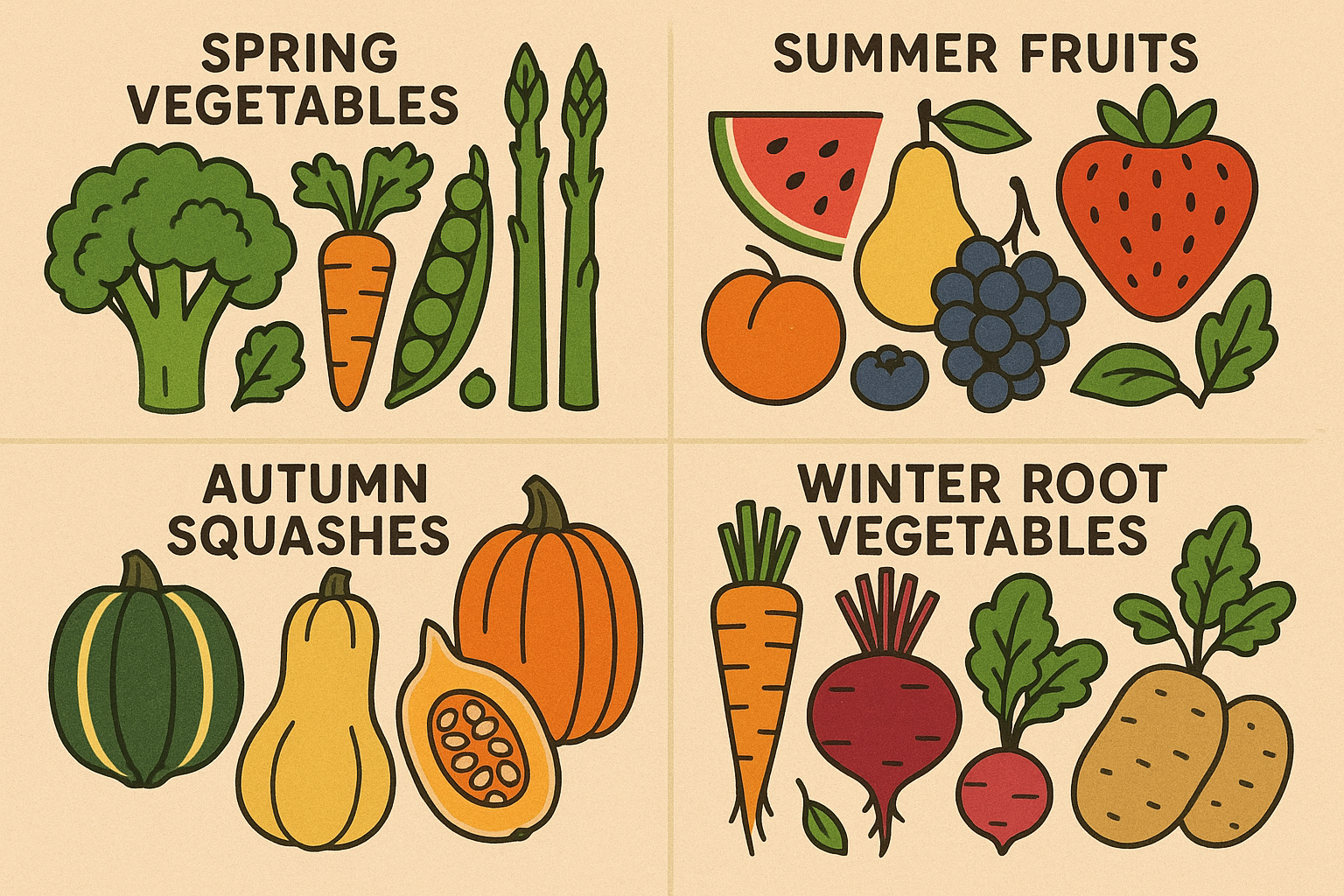
When Things Go Wrong: Troubleshooting Like a Pro
First off, if things aren’t going smoothly, you’re not doing anything wrong. I repeat: YOU ARE NOT DOING ANYTHING WRONG. Most of the time when BLW feels hard, it’s because we’re missing some piece of the puzzle, not because we’re bad at this parenting thing.
Most BLW challenges stem from misunderstanding underlying developmental or environmental factors rather than problems with the approach itself. Food rejection, excessive mess, and apparent lack of progress usually follow predictable patterns that can be systematically addressed once you understand the root causes.
I went through periods where everything seemed to be falling apart with our BLW journey. My baby was rejecting foods she had previously enjoyed, meals were becoming battlegrounds, and I was questioning whether we were doing something wrong. Understanding these common patterns helped me realize that most challenges have solutions.
Decoding Your Baby’s Food Rejection Patterns
Food rejection in BLW follows predictable patterns related to texture sensitivity, flavor complexity, or developmental readiness that can be systematically addressed. Rather than assuming your baby “doesn’t like” certain foods, understanding these patterns allows you to modify your approach and successfully introduce a wide variety of foods over time.
I used to take food rejection personally, thinking I had failed somehow when my daughter pushed away foods I had carefully prepared. Learning to analyze rejection patterns changed everything about how I approached challenging foods during BLW.
The Rejection Analysis System That Actually Works
Tracking rejection patterns in a food diary, reintroducing rejected foods in modified forms after 1-2 weeks, pairing rejected foods with accepted favorites, and considering sensory processing factors creates a systematic approach to expanding your baby’s food acceptance through BLW.
Similar to how intuitive eating requires listening to body signals, successful BLW involves understanding and respecting your baby’s natural feeding cues and rejection patterns. This isn’t about forcing foods but about understanding and working with your baby’s developmental needs.
Food Rejection Troubleshooting Checklist:
- Note time of day rejection occurred
- Document baby’s mood and energy level
- Record texture, temperature, and presentation method
- Check for teething or illness symptoms
- Consider if new food was paired with familiar foods
- Note family stress levels during meal
- Track patterns over multiple exposures
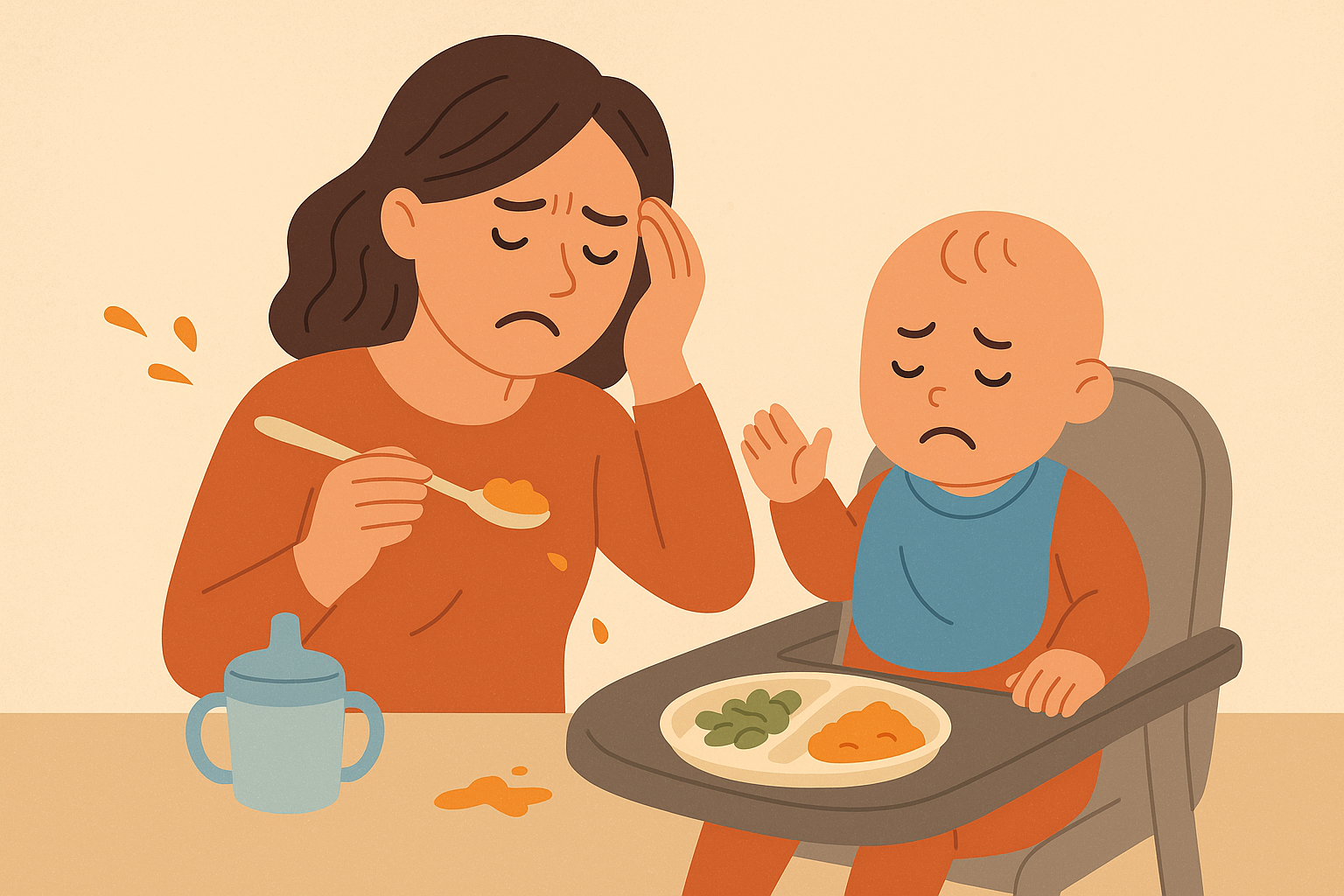
The Mess Management Psychology That Saves Your Sanity
Can we talk about the mess for a second? Because holy moly, the mess. The mess created during BLW serves important developmental purposes, and over-managing it can interfere with learning while under-managing it creates family stress. Setting up easy-to-clean eating spaces, allowing natural exploration while maintaining basic boundaries, involving baby in age-appropriate cleanup, and reframing mess as evidence of learning creates a balanced approach.
This supports development without destroying your home. I had to completely shift my mindset about mess during BLW meals. Instead of seeing dropped food as waste, I started viewing it as evidence that my baby was actively exploring and learning. There will be food on the floor. So much food on the floor. Your Instagram-worthy meal prep might end up as abstract art on the wall. And that’s totally normal.
The Success Markers You Should Actually Be Watching
True BLW success isn’t measured by how much food is consumed initially, but by specific behavioral and developmental markers that predict lifelong healthy eating patterns. Understanding these markers helps you recognize progress even when it doesn’t look like traditional feeding success.
I was so focused on how much my baby was eating that I missed all the incredible developmental progress happening right in front of me during BLW. You know what you’re thinking – “But are they getting enough nutrition?” I get it, I worried about this too.
The Intuitive Eating Signs That Predict Future Success
Babies who successfully develop through BLW show specific signs of intuitive eating that differ markedly from traditionally weaned children. Observing self-regulation behaviors, noting variety acceptance and willingness to try new foods, watching for emotional eating patterns, and documenting progress in eating independence creates a comprehensive picture of your baby’s developing relationship with food.
These behavioral markers are far more predictive of future eating success than the amount of food consumed during any individual meal. When my son started pushing his plate away when he was full, even when there was still food on it, I knew he was developing the internal awareness that would serve him throughout life.
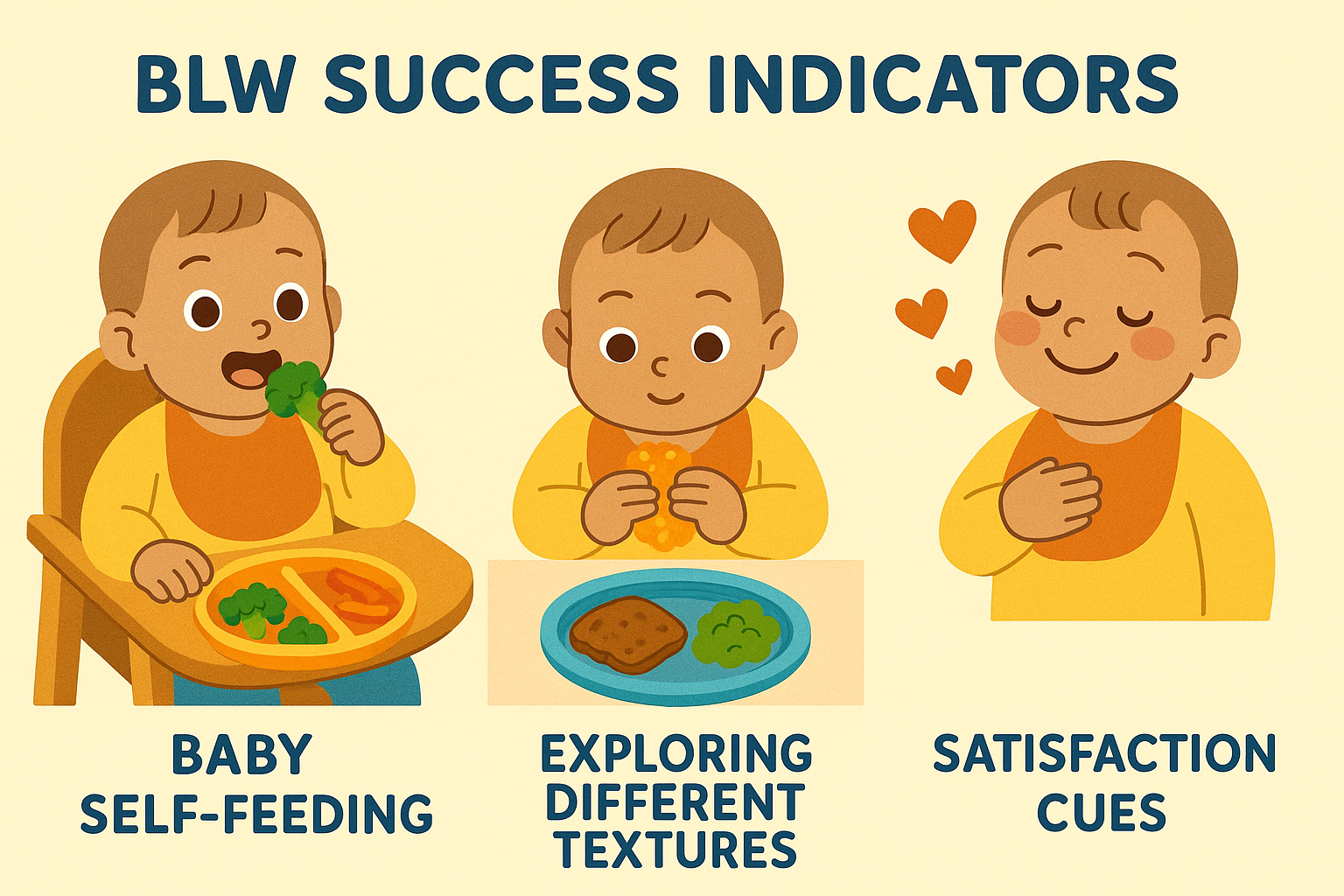
Look, I know this sounds overwhelming. You’re probably thinking “Great, now I have to worry about programming my baby’s gut bacteria too?” But here’s the thing – you don’t need to stress about getting every meal perfect. Even doing some of these things some of the time makes a difference.
For parents seeking the highest quality organic ingredients to support their BLW journey, Organic Authority’s carefully curated selection of clean, bioavailable nutrition products provides the foundation for optimal development. Their rigorous standards for ingredient purity and transparency align perfectly with the developmental importance of this critical feeding window.
Final Thoughts
Here’s what I wish someone had told me when I started this journey: some days will be amazing, some days will be disasters, and most days will be somewhere in between. Your baby will reject foods they loved yesterday. You’ll question everything. You’ll want to give up and just go back to pouches.
That’s all completely normal.
Baby led weaning represents far more than a feeding method – it’s a comprehensive approach to early childhood development that impacts neurological growth, immune system programming, and social-emotional learning. The scientific framework behind BLW reveals why this approach creates such dramatically different outcomes compared to traditional weaning methods.
Understanding these mechanisms empowers you to make informed decisions that support your baby’s optimal development during this critical window. The investment you make in implementing BLW thoughtfully during the 6-24 month period creates developmental advantages that compound throughout your child’s life.
We’re talking about influences on academic performance, emotional resilience, and lifelong health patterns. Every meal becomes an opportunity to support your baby’s developing brain, establish beneficial gut bacteria, and create positive associations with food and family connection.
The beautiful thing about BLW isn’t that it’s perfect – it’s that it works even when it’s messy and imperfect. Every time your baby explores a new food, even if they don’t eat it, they’re learning. Every time they push food around their tray, they’re developing. Every time they make a mess, they’re growing.
The mess, the uncertainty, the moments of doubt – they’re all part of a process that’s literally rewiring your baby’s brain for success. When you understand what’s really happening during those chaotic high chair moments, you realize you’re not just feeding your baby. You’re laying the foundation for a lifetime of healthy relationships with food, stress management, and learning.
And honestly? Years from now, you won’t remember the stress or the mess. You’ll remember watching your little human discover the world one bite at a time. And that’s pretty amazing.
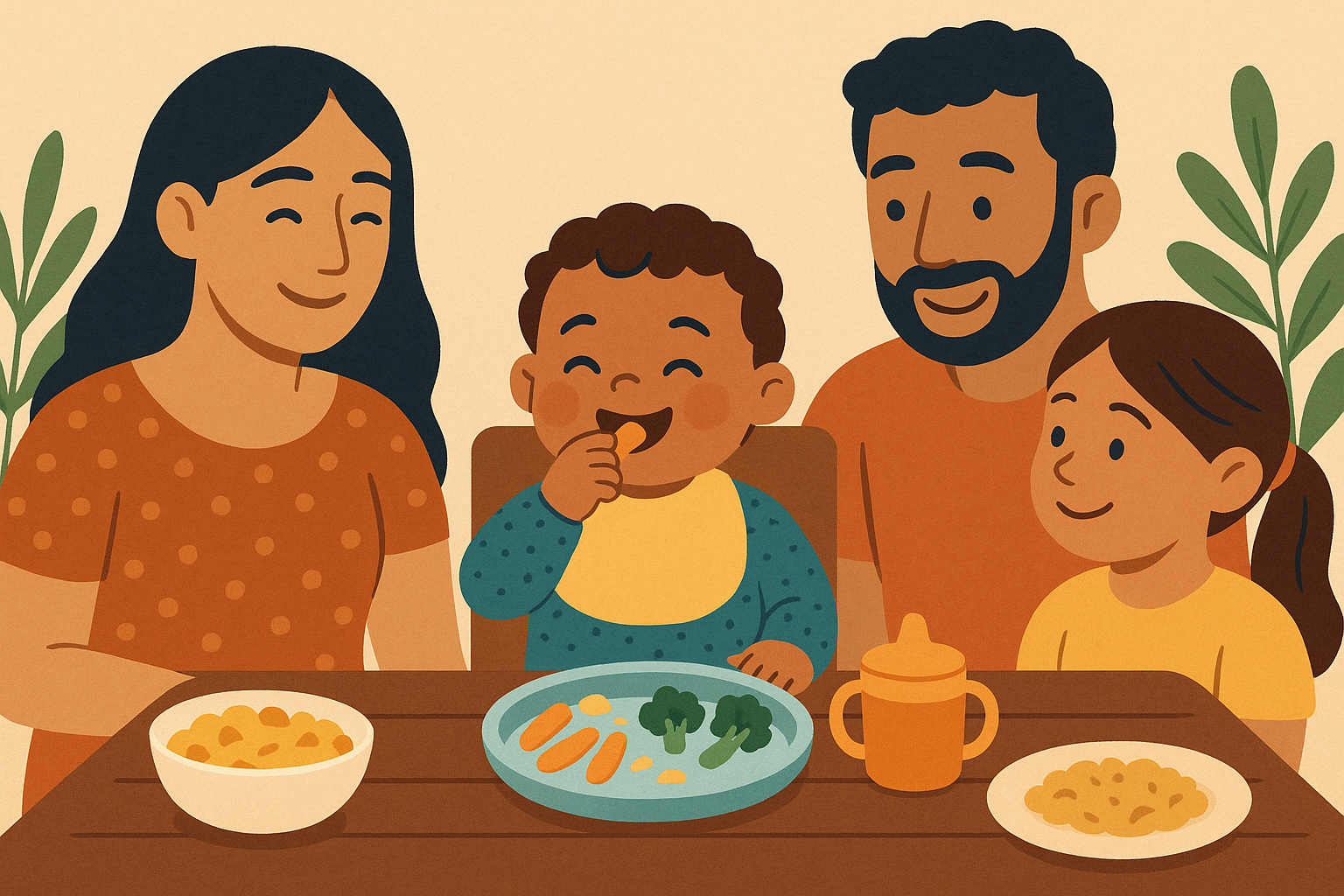
[Keywords to Include:]
[Content Summary:]

